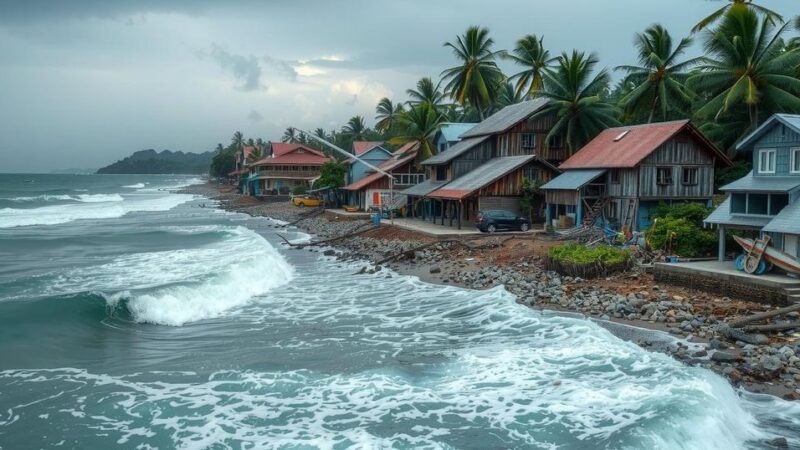Africa is experiencing severe climate challenges alongside a crippling debt crisis, necessitating urgent, comprehensive debt relief to foster sustainable development. With significant environmental vulnerabilities, over half of African countries allocate more to debt interest than health care. A coordinated debt relief structure, incorporating climate considerations, is essential to allow for investment in renewable energy and infrastructure, unlocking the continent’s potential for green growth. Global summits scheduled for late 2024 provide an opportunity for African leaders to advocate for meaningful change, highlighting the need for immediate action to support a sustainable, equitable future.
Africa is facing an unprecedented climate crisis compounded by a staggering debt burden that threatens the continent’s ability to pursue sustainable development. Recent extreme weather events, including the hottest summer on record and severe flooding linked to El Niño, have accentuated the urgency for comprehensive efforts to combat climate change. As world leaders prepare for crucial summits in late 2024, including significant meetings organized by the IMF, G20, and the UN Climate Change Conference, it is imperative that the needs of African nations are prioritized amidst a chronic sovereign-debt crisis that leaves 17 out of the 20 countries most vulnerable to climate change situated on the continent. The financial challenges are alarming; public debt in Africa surged by an unprecedented 240% between 2008 and 2022. As a result, more than half of African nations now allocate greater expenditure on interest payments than on health care, severely limiting their ability to invest in green projects. Consequently, there exists a critical call for substantial debt relief to empower these nations to finance climate resilience initiatives, renewable energy, and infrastructure projects necessary for a sustainable future. Unfortunately, existing frameworks like the G20’s Common Framework for Debt Treatments have proven ineffective, as they lack adequate solutions and participation from essential creditors. For African countries to pivot towards sustainable growth, comprehensive debt relief is required, grounded in a three-pillar strategy: firstly, significant reductions in debt owed to bilateral creditors and multilateral development banks; secondly, the establishment of mechanisms to encourage participation from private creditors in debt restructurings; and lastly, the provision of credit enhancements to non-distressed nations to enable continued investments. A vital reform must include climatic considerations in the IMF’s debt sustainability analyses. Current evaluations do not factor in the necessity for investments in clean energy and future-oriented industries, neglecting the integration of climate risks into financial assessments. A coordinated approach encompassing all creditor types, ensuring equitable distribution of burdens, is essential to liberate Africa’s potential for green growth. With abundant renewable resources and a youthful workforce, Africa is poised to become a renewable energy leader, bolstering both regional and global objectives in combating climate change. As African leaders prepare for 2025, they are presented with an opportunity to enact necessary reforms aimed at addressing the intertwined crises of debt and climate change. With support from current key countries holding prominent roles in international discussions, there exists a critical moment for the continent to advocate for meaningful debt relief and reforms in the global financial architecture. This dual approach to the climate and debt crises is crucial. The international community must take immediate action to aid Africa in its pursuit of a sustainable and equitable green future.
In recent years, Africa has grappled with severe climatic changes and a burgeoning debt crisis. The direct impacts of global warming are evident in extreme weather conditions, exacerbating existing socio-economic vulnerabilities. The continent’s economies have been battered by external shocks, including rising inflation, interest rate hikes, and geopolitical conflicts, leading to a profound increase in public debt. The need for debt relief has never been more critical as nations struggle to allocate resources for both basic services and climate resilience, which is fundamental to achieving sustainable growth. The upcoming summits in late 2024 present a pivotal opportunity to address these pressing challenges at a global level.
In conclusion, the climatic and economic predicaments faced by African nations are significantly interconnected, necessitating a holistic response that does not neglect either sector. Substantial debt relief, along with smart financial strategies, can enable African countries to invest in sustainable development and climate resilience. The collective action of the international community is paramount in supporting Africa’s aspirations for a green future, as the continent holds remarkable potential for renewable energy and economic growth. The forthcoming years will be crucial for implementing reforms that bridge the gap between debt relief and climate action, ultimately shaping a prosperous future for Africa.
Original Source: www.koreatimes.co.kr







